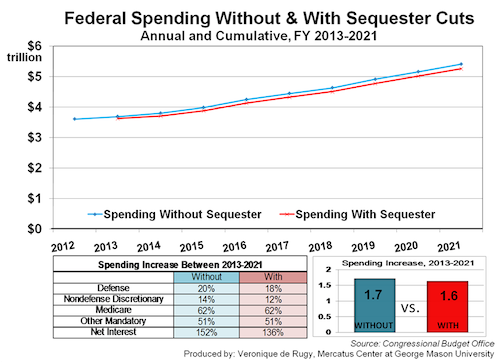Let’s assume, perhaps out of an excess of pessimism, that the Supercommittee does not agree on $1.2 trillion in savings, the mandated cuts are triggered and no legislation passes avoiding such cuts.
How much money would actually be saved by the sequestration of the otherwise planned spending?
The answer, disappointingly, is: Not much.
As a study (see http://mercatus.org/publication/federal-spending-without-sequester-cuts) by Veronique de Rugy at George Mason University shows, using Congressional Budget Office numbers, the “sequestration” of planned spending would result in total additional spending by 2011 of $1.6 trillion; without sequestration, the additional spending would be $1.7 trillion.
So, the total effect of sequestration would be a reduction in spending of less than 6% and far less than the President’s Fiscal Commission recommended.
Examine her graph below, and if you can see the difference between the two lines, your eyes are better than mine:

The takeaway? If the Supercommittee doesn't reach agreement, and the planned amounts are sequestered, we’re still headed off a financial cliff, albeit at a trot, rather than a gallop.
If they do reach agreement, but only to the extent of the otherwise sequestered amount, and fail to "think bigger," the same result applies.
It makes one wonder a bit as to what the fuss is about in the media re whether or not the sequestration trigger gets pulled.
It makes one wonder a bit as to what the fuss is about in the media re whether or not the sequestration trigger gets pulled.
No comments:
Post a Comment